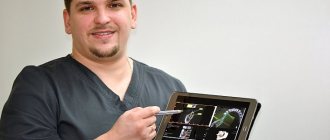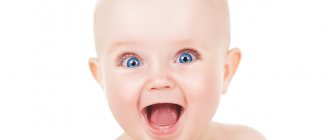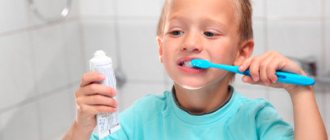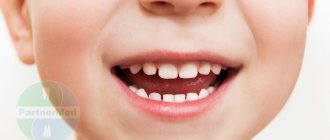Every person changes their milk teeth to molars. At 6-7 years old, the first incisor falls out, and tooth replacement ends after 20, when “eights” appear. New teeth grow according to an individual schedule, so the parent’s task is to teach the child to properly care for the oral cavity and monitor how the children’s molars grow.
When does a child's molars come out?
Growing permanent teeth is a big job for the body, which we rarely notice. Changes begin at 3 years - the rudiments of molars are formed. At age 5, noticeable gaps appear between the baby teeth to make room for new “tenants.”
Which teeth come out first is determined by a lottery - genetics. In half of the cases, growth begins with “sixes”. Molars grow by the age of 7-8 years, at the same time the front incisors change.
Teeth grow slowly but painlessly. At 14, the main bite is already formed. “Late” wisdom teeth - third molars grow in a few years, at 18-21 in most adults.
How many teeth change in children: order of eruption
During the replacement process, the child loses all twenty baby teeth, and 32 permanent teeth grow to replace them. Very often, the child first grows the first molars, which are absent in the primary dentition, and not the central incisors, as is commonly believed. In the future the sequence is as follows:
- lower, and behind them upper incisors in the center of the jaw;
- lateral incisors located above and below;
- 1st premolars;
- fangs;
- 2nd premolars;
- The 2nd and 3rd molars (“wisdom teeth” may never arrive).
It is not by chance that this sequence is laid down by nature. It takes into account the growth rate of the jaw and skull bones, which means that if the order is followed, the correct bite is formed.
Molars in children: symptoms of eruption
In almost all children, molars appear painlessly and unnoticeably. However, there are exceptions when the growth of permanent teeth is accompanied by unpleasant sensations. A common symptom when teething is increased temperature, up to 38 ºС. The child also complains of:
- weakness and drowsiness due to decreased immunity;
- runny nose, excessive salivation;
- inflammation of the gums;
- itching, pain while eating.
Massaging your gums will help relieve discomfort in your mouth. To relieve inflammation, use dental gel. Important: Disinfect your hands or wear sterile gloves before applying.
Consult your dentist before purchasing medications. Severe inflammation is a signal that teeth are not growing properly. Without treatment, the child's bite may become deformed.
Complications during teething
- bite defects. Molars are larger in size than baby teeth; there may not be enough space in a narrow jaw. The bite changes if the baby teeth do not fall out, but new ones begin to grow.
- hyperdentia – teeth grow in a second row. This happens for various reasons, most often - the baby tooth holds tightly and the root one looks for other ways.
- teeth don't grow. If the milk one falls out, but the permanent one is delayed for six months, you need to consult a doctor. Poor dental growth is one of the signs of problems with the immune system in children.
- caries and pulpitis. The first sign of enamel destruction is the child’s complaints of a sore throat, sweet and hot foods “getting” into the tooth. If pulpitis affects the molars, children’s body temperature rises and severe pain appears. Then treatment of pulpitis is urgently needed without delay.
Teething disorders - symptoms and treatment
In case of teething problems, symptomatic treatment is carried out. Its purpose is to eliminate pericoronitis, oral abscess and osteomyelitis.
Treatment of pericoronitis
Treatment of pericoronitis is carried out on an outpatient basis. If the tooth germ is positioned correctly and there is enough space for the dental arch, then surgical treatment is the most preferable option. The mucous membrane in the area of the tooth crown is completely excised. As a result, access to the chewing and lateral surfaces of the crown appears. The operation is performed under anesthesia and can be performed either with scissors or a scalpel, or with more modern methods: cryodestruction, laser and electric knife.
pericoronarotomy can be performed - an operation during which the mucous membrane above the tooth crown is dissected. As a result, tooth surfaces that were previously covered by a hood of mucous membrane are exposed.
After surgical treatment, drug therapy :
- Antibacterial agents are selected individually, taking into account the microflora. It can be:
- Inhibitor-protected penicillins that destroy anaerobic and aerobic microorganisms. Amoxicillin with clavulanic acid is most effective.
- Lincomycin and Clindamycin act against Staphylococcus aureus.
- Metronidazole is not effective against facultative anaerobes and aerobes, but together with other antibiotics it will help cope with mixed microflora.
- Cephalosporins act only together with Metronidazole and Clindamycin, since almost all anaerobic microorganisms are insensitive to them.
- The latest generations of fluoroquinolones are effective against gram-positive bacteria, but each drug has its own level of activity.
- Non-steroidal anti-inflammatory drugs.
- Antihistamines [10].
- Detoxification therapy consists of drinking plenty of warm drinks rich in vitamins, such as compotes and fruit drinks. Sometimes in difficult situations, an isotonic solution is administered intravenously.
To alleviate local symptoms and reduce inflammation, baths with antiseptic solutions are used: a pale pink solution of potassium permanganate, 0.01% Miramistin solution or 0.05% Chlorhexidine.
Treatment of oral abscess
Treatment for an oral abscess includes surgery and medication. Depending on the location of the abscess and the general condition of the patient, it can be performed in a clinic or in a hospital. During the operation, the purulent-inflammatory focus is opened, the postoperative wound is treated with antiseptics and drained.
After surgery, medications must be prescribed. They are similar to those used to treat pericoronitis. To detoxify, it is recommended to drink plenty of alkaline liquids, such as mineral water and cranberry juice.
For several days after the operation, the wound is bandaged daily and treated with antiseptics.
Treatment of osteomyelitis
If osteomyelitis is detected, the patient is immediately hospitalized. The erupting tooth is removed, and all purulent foci are carefully treated. Antibacterial drugs are administered intravenously. For detoxification, saline solutions are used, which are also administered intravenously.
Recommendations for caring for a child's molars
Children's molars require careful care. Young enamel is sensitive to the external environment and bacteria that cause caries. Therefore, it is important to use hygiene products.
The best prevention is to teach your child to maintain good oral hygiene before a permanent bite has formed. To keep your teeth healthy, you need to follow a few simple steps:
- brush your teeth every day ☑️. Brush at least twice a day, use dental floss and mouthwash.
- correct diet ☑️. Sweet plaque on teeth is the best food for bacteria. After meals with a lot of carbohydrates, brush your teeth or rinse your mouth. Avoid snacking when you can't take care of your teeth.
- regular preventive examinations ☑️. You need to visit the dentist once every six months. Treat teeth immediately when problems are detected.
- strengthen teeth ☑️. Eat a balanced diet, take vitamin and mineral complexes rich in calcium.
- Visit the dentist regularly ☑️ and have your teeth professionally cleaned.
Taking care of your teeth doesn't take much time, but taking simple steps now will help you maintain beautiful, healthy teeth for life.
Permanent teeth
The change in the primary bite begins in children aged 5-6 years. By this time, the roots of baby teeth begin to dissolve and tooth mobility appears.
- At this age (5-6 years), the lower front incisors are the first to be replaced. In parallel with them, at about 6 years of age, the first permanent chewing teeth appear. Often their appearance is not even noticed, since they erupt behind the milk teeth.
- At 6-7 years old, the upper front incisors are replaced
- At 7-9 years of age, the baby teeth will fall out and be replaced by permanent lateral incisors.
- At the age of 9-11 years , the fourth and fifth milk teeth (molars) will be replaced by the 1st and 2nd premolars.
- The last ones, at the age of 11-13 years, will be replaced by permanent teeth - fangs.
- By the age of 12-13, all baby teeth will be replaced by permanent ones and the child’s mouth now has 24 teeth. Oral hygiene often suffers at this age. This is due to adolescence. Carise especially often affects the fissures (grooves) of the sixth teeth - molars. The process happens very quickly and often develops into pulpitis! Therefore, it is important to pay attention to caries prevention. A good way to protect the fragile enamel of permanent teeth is by sealing fissures and maintaining some professional hygiene. and, of course, following some rules.
- At 13-14 years of age, the second molars (seventh teeth) will erupt.
- And already at the age of 18, and sometimes later, wisdom teeth appear.
In order to keep your teeth healthy and straight, we recommend that you come for a preventive examination to the dentist every 6 months and visit the orthodontist at the ages of 6, 12 and 18 years.
Consequences of early destruction of primary teeth
After the early removal of a baby tooth, the gum in its place becomes overgrown, and the permanent one is deprived of its natural landmark. This leads to phenomena such as:
- dystopia - eruption of a permanent tooth outside the dental arch;
- retention - the occurrence of a formed tooth in the thickness of the jaw bone.
If the baby tooth does not receive treatment, and the inflammatory process spreads to its roots, then the permanent follicle located under them is damaged. In this case, the permanent one may die, and then its place in the dentition will remain empty. The absence of a tooth is confirmed by radiography.
How to distinguish baby teeth from permanent ones?
Both molars and baby teeth have a similar structure, but have a number of external differences.
- Thus, milk ones are on average lighter and whiter than permanent ones, which are distinguished by a yellowish enamel tone.
- On average, a molar is larger than its primary tooth.
- Permanent ones have a thicker layer of hard tissue and a less developed pulp.
- Dairy varieties have thinner and shorter roots.
It is important for all parents to remember that both baby and permanent teeth of children must be protected, and any problems that arise in their growth and development must be resolved immediately. Specialists from the “A-Medic” network of medical clinics can help them with this.
What to do if the tooth, on the contrary, does not loosen
If a molar is already visible above the baby tooth, which is about to erupt, then this is a reason to visit an orthodontist. If such a baby tooth is not removed in a timely manner, then an expensive bite correction will be required to force the permanent tooth to fall into its proper place.
In this case, an orthopantomogram will also help, which will allow you to see where the molars are located.











